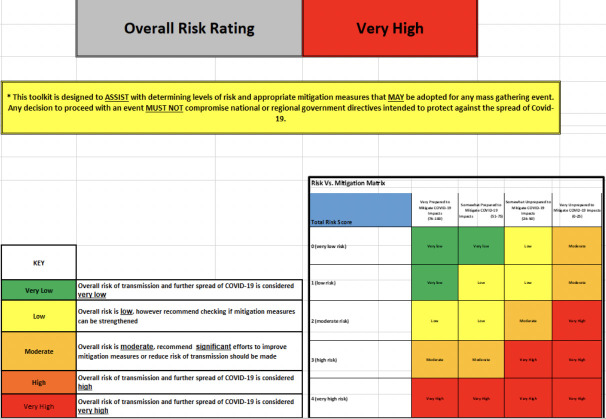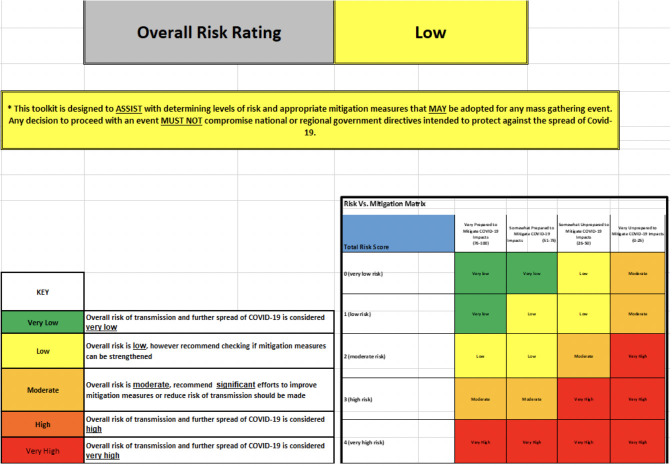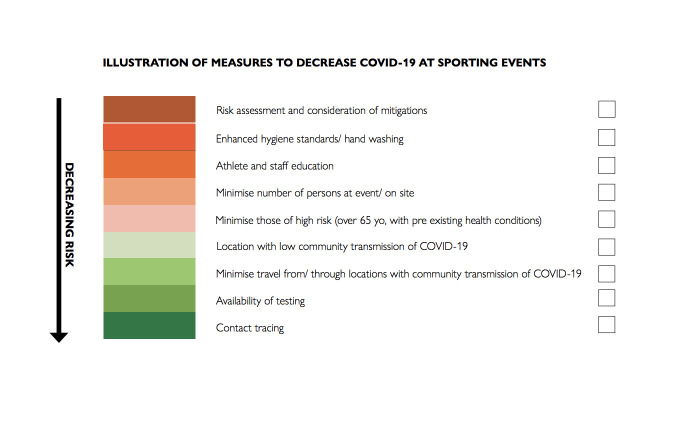The COVID-19 pandemic has had, and will have, profound effects on every person on earth. Measures advocated by the WHO and put in place by national governments, businesses and individuals will save millions of lives, but current movement restrictions (ie, various degrees of lockdown) cannot continue indefinitely. The activity restrictions imposed by governments are designed to reduce human-to-human transmission; they buy time and allow international collaboration between governments and internally to build and allocate the resources and systems to
Test: every suspected case where testing is merited and available while having effective prevention strategies in place.
Trace: follow up all confirmed cases of COVID-19 and contact trace every relevant contact to identify and cut off transmission.
Treat: manage all cases effectively, with adequate intensive care unit capacity, ventilators and staff.
Rightly, professional sport has been placed on hold during the COVID-19 pandemic. The WHO (#BeActive) and many governments continue to promote certain types of moderate physical activity for the benefits it confers on the immune system and physical and mental health.1–4 Sport has health, social and economic benefits for individuals and society, and when the COVID-19 pandemic is better ‘controlled’, it may be appropriate to reintroduce community sport and professional sport. In this editorial, we opine on what needs to be in place for professional sport to recommence.
Emerging from lockdown: public health
The relaxation of movement/activity/business restrictions is likely to happen over a gradual period, and time frames will differ across nations and even within nations. The following is expected5:
Lockdowns will be lifted strategically and in a stepwise fashion; the effects of easing will be carefully monitored, given the 2-week latency between actions (eg, allowing more social engagement) and outcomes (no change in infection rates or an increase in cases).
Countries and/or regions with lower community transmission of cases will begin easing restrictions before those with higher community transmission.
Physical distancing and enhanced standards of personal hygiene will continue longer term. Some, like regular handwashing, should be part of routine behaviour forever.
Risk assessment (systematically looking at risk and potential consequence of COVID-19) and control measures designed to eliminate, reduce or minimise the risks will be used.6–8
Risk assessment of sporting events
Mass gatherings such as a large number of participants and particularly crowds attending sporting events likely increase risk of transmission of COVID-19.9 Additionally, there are some sports (eg, golf and time trial cycling) where social distancing is possible, and others (eg, football and rugby) where it is not practical. Travel (use of airports and hotels) can also increase risk, although this may be no different from travel on other business. If professional sport is to return in the near future, event organisers must accept that assessment of risk must be undertaken and measures put in place to ensure any risks from the event are less than the benefits.
The WHO highlights five key factors in determining risk10 :
Will the event be held in a country that has documented active local transmission of COVID-19 (community spread)?
Will the event be held in a single venue or multiple venues/cities/countries?
Will the event include international participants (athletes and spectators) from countries that have documented active local transmission of COVID-19 (community spread)?
Will the event include a significant number of participants (athletes or spectators) at higher risk of severe COVID-19 disease (eg, people over 65 years of age or people with underlying health conditions)?
Will the event include sports that are considered at higher risk of spread for COVID-19 (eg, contact sports)?
We illustrate in figure 1 that, for a non-closed doors, English Premier League football match, played in April, the risk is very high, and the match should not proceed regardless of government policies, which at present would also preclude it going ahead.
Figure 1.
Risk analysis for English Premier League football hosted in April.
Once the risk assessment is conducted, event organisers should refer to mitigation measures to see where these considerations can be incorporated into the planning of the events to further decrease the risk of spread of COVID-19. If, for example, a match was postponed to August, was played behind closed doors, substantial but achievable mitigations including enhanced hygiene, social distancing where practical, the ability to test and contact trace were put in place and transmission was (for illustration) present but significantly less in the host country, then the risk from that event can be reduced to low. Players would need to have time to gain fitness prior to matches resuming. Discussion with government, local health authorities, event organisers and the participants could take place, regarding suitability to proceed and what other controls can further decrease risk (figure 2).
Figure 2.
Risk assessment for a closed door English Premier League football match, where local transmission is reduced and risk mitigation procedures are put in place.
If community transmission is low and adequate risk mitigation procedures are in place, the overall risk can be very low. This could apply to a local golf competition, where the sport is outdoors, social distancing is possible, and participants are <65 years old, fit and well. Key measures to decrease risk of COVID-19 at sporting events are illustrated in figure 3.
Figure 3.
Illustration of options to decrease risk of sporting events during the COVID-19 pandemic.
We suggest the following documents can serve as a guide to those undertaking risk assessments for events within their sports:
WHO key planning recommendations for mass gatherings.6
WHO considerations for sports federations/sports event organisers when planning mass gatherings in the context of COVID-19.7
WHO mass gathering sporting risk assessment.8
If sporting events return, close liaison with the participants, local/national government and public health authorities is necessary. Event organisers must
Minimise risk of transmission for all groups of sporting event participants.
Work to ensure readily available accurate testing while not taking these from health systems that need them most.
Be able to accurately contact trace.
Further important steps include individual sporting bodies producing guidance regarding return to training postrestrictions, policies and procedures for testing, and management of players diagnosed with COVID-19, recognising the science is fast evolving.
Conclusion
Professional sport, as well as its resumption, is a secondary concern in the context of the COVID-19 pandemic globally. However, international collaboration has enabled major sporting events to proceed during WHO declared public health emergencies, including Vancouver 2010 Olympic Games during the H1N1 pandemic, and Rio 2016 Olympic Games during the Zika outbreak. We should start planning to resume sporting events, given the health, social and economic benefits of professional sport and the substantial planning and work required prior to any resumptions. In this editorial, we build on WHO guidance and tools and discuss the factors and risk assessments which should be in place prior to sport returning.
bjsports-2020-102539supp001.xlsx (84.2KB, xlsx)
Acknowledgments
We wish to acknowledge input received from Amaia Artazcoz Glaria, Maurizio Barbeschi, Fiona Bull and Albis Francesco Gabrielli, WHO; Andy Sinclair-Scottish Government, Anna Deignan, UK Government, Tina Endericks, Global Health Security Global Public Health and Lucia Mullen, John Hopkins Bloomberg School of Public Health.
Footnotes
Twitter: @docandrewmurray, @vgouttebarge, @andy_massey
Correction notice: This article has been corrected since it published Online First. The acknowledgement section has been updated.
Contributors: AMu and SC drafted the initial version of this manuscript. AMa, MB and VG modified the subsequent versions. All authors approved the final version of the manuscript.
Funding: The authors have not declared a specific grant for this research from any funding agency in the public, commercial or not-for-profit sectors.
Competing interests: None declared.
Patient consent for publication: Not required.
Provenance and peer review: Not commissioned; internally peer reviewed.
References
- 1. Lee I-M, Shiroma EJ, Lobelo F, et al. . Effect of physical inactivity on major non-communicable diseases worldwide: an analysis of burden of disease and life expectancy. Lancet 2012;380:219–29. 10.1016/S0140-6736(12)61031-9 [DOI] [PMC free article] [PubMed] [Google Scholar]
- 2. Brolinson PG, Elliott D. Exercise and the immune system. Clin Sports Med 2007;26:311–9. 10.1016/j.csm.2007.04.011 [DOI] [PubMed] [Google Scholar]
- 3. World Health Organisation Be active during COVID-19- press Briefing. World health organisation, 2020. Available: https://www.who.int/news-room/q-a-detail/be-active-during-covid-19 [Accessed 16 Apr 2020].
- 4. UK Government Coronavirus (COVID-19): what you need to do. Available: https://www.gov.uk/coronavirus [Accessed 14 Apr 2020].
- 5. World Economic Forum Prepare for a ‘new normal’ as lockdown restrictions ease. Monday’s WHO Covid-19 Briefing. World Economic Forum,, 2020. Available: https://www.weforum.org/agenda/2020/04/13-april-who-briefing-coronavirus-covid19-lockdown-restrictions-guidance/
- 6. WHO Key planning recommendations for mass Gatherings in the context of COVID-19: interim guidance., 2020. Available: https://www.who.int/publications-detail/key-planning-recommendations-for-mass-gatherings-in-the-context-of-the-current-covid-19-outbreak
- 7. WHO Considerations for sports federations/sports eventorganizers when planning mass gatherings in the context of COVID-19, 2020. Available: https://apps.who.int/iris/bitstream/handle/10665/331764/WHO-2019-nCoV-Mass_Gatherings_Sports-2020.1-eng.pdf
- 8. WHO Mass gathering sporting risk assessment, 2020. Available: https://www.who.int/emergencies/diseases/novel-coronavirus-2019/technical-guidance/points-of-entry-and-mass-gatherings
- 9. Rashid H, Haworth E, Shafi S, et al. . Pandemic influenza: mass gatherings and mass infection. Lancet Infect Dis 2008;8:526–7. 10.1016/S1473-3099(08)70186-5 [DOI] [PMC free article] [PubMed] [Google Scholar]
- 10. McCloskey B, Zumla A, Ippolito G, et al. . Mass gathering events and reducing further global spread of COVID-19: a political and public health dilemma. Lancet 2020;395:1096–9. 10.1016/S0140-6736(20)30681-4 [DOI] [PMC free article] [PubMed] [Google Scholar]
Associated Data
This section collects any data citations, data availability statements, or supplementary materials included in this article.
Supplementary Materials
bjsports-2020-102539supp001.xlsx (84.2KB, xlsx)





